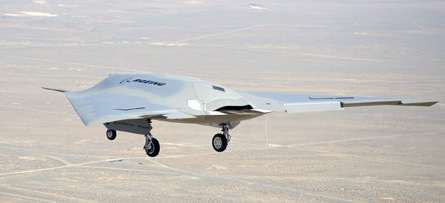Manned combat aircraft will remain at the tip of the spear for at least a generation and a half because in the near-term, unmanned aircraft are unable to operate inside heavily defended airspace.
"When and if we're challenged in the A2/AD [anti-access/area denial] environmentthis is why manned aviation-[Lockheed Martin] F-35s are a case in point, [Northrop Grumman] B-2s another -- where they will be a part of our force structure," says outgoing US Air Force chief of staff Gen Norton Schwartz. "I would estimate at least for a generation and a half, 30 years probably--maybe more, probably not less."
Right now, unmanned aircraft like the General Atomics MQ-1 Predator and MQ-9 Reaper are not able to operate inside A2/AD environments.
"At least for the near term, the remotely piloted aircraft capability is not for contested air space," Schwartz says. "It is a benign air space capability."
 |
|---|
| ©Boeing |
Most current unmanned aircraft do not have the maneuverability or self-defense systems to adequately protect themselves in an A2/AD environment, the USAF says. In the future, the USAF needs to work on "developing better self-protection, increased maneuverability, smaller signatures, more robust/redundant network integration, and situational awareness inputs from other cross-domain sensors."
Eventually, unmanned aircraft will become capable of accomplishing more mission types, but will not necessarily replace manned aircraft in all mission areas, the service says.
The bottom-line, Schwartz says, of a day when unmanned aircraft might operate deep inside enemy airspace: "There are some things we're not yet prepared to do, and it's not that it might not happen at some point, but it's not a near-term eventuality."
To penetrate into the A2/AD environment, the USAF will rely on space, cyber and 5th generation fighters like the Lockheed Martin F-22 and F-35. But cyber-warfare will play an increasingly large role. "As we take down threats through kinetic or cyber-attacks, we open windows in the anti-access environment to fly our less robust systems, whether manned or unmanned," the USAF says.
But that does not mean that the current fleet of unmanned aircraft is entirely irrelevant. The USAF intends to continue to integrate new payloads onto its current fleet when it can-if it has money available. "All our RPAs [remotely piloted aircraft] have a role in that fight. Some are more suited to the higher threats and some to protecting logistics lines," the USAF says. "In an A2/AD environment, our current RPAs are more likely suited for pre-conflict and follow-on forces once regional or theater air supremacy has been achieved." For its next-generation unmanned aircraft, the USAF is working closely with the US Navy on that service's unmanned carrier-launched surveillance and strike (UCLASS) aircraft. The USAF aircraft will be based on the USN's initial capabilities document, but the service does not have any money allocated to the project. "We have assigned a dedicated acquisition liaison officer at the navy programme office specifically to coordinate advanced RPA capabilities with the navy," the USAF says.
The USAF says that future developments will focus on multi-role unmanned aircraft which are collaboratively networked with manned aircraft. But while the service will emphasize teaming with other manned or unmanned aircraft through machine-to-machine data links, target designators and markers, or even secure voice communications for so-called "buddy" attacks, a next-generation drone will retain the ability to fly as a standalone system, the USAF says. The service also wants a next generation aircraft to be able operate in all weather conditions-something today's unmanned aircraft fleet cannot do.
Next generation unmanned aircraft will likely be flown using a family of distributed control stations, the USAF says. "Work is underway to develop technologies that optimize the human interfaces and level of autonomy for the mission phase or type of mission with rapid seamless handover of control between the control stations," the service says. "Transit operations workstations will fly multiple UASs [unmanned air systems] simultaneously while complex missions will have advanced displays and controls."
The USAF is also exploring the use of expendable air-launched small UASs (SUAS) which could expand the reach of manned and unmanned platforms. "Air Launched-SUAS may address the need for off-board sensing from manned and remotely piloted aircraft to conduct off-board sensing missions, focused lethal engagements, and multiple diverging target tracking."
But the USAF may also expand the use of SUASs due to their expendability and lower costs of acquisition and training, the service says.
Source: Flight International
















